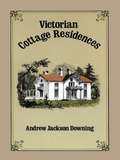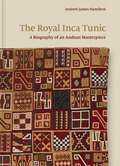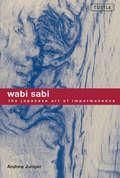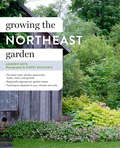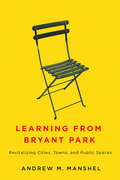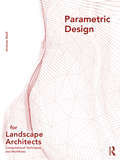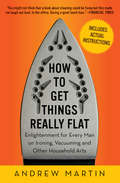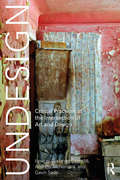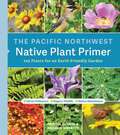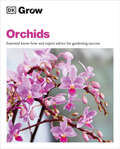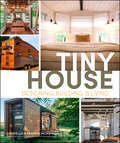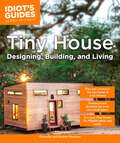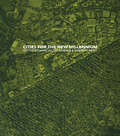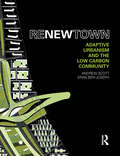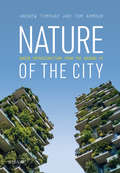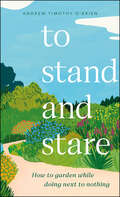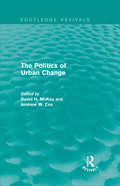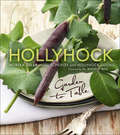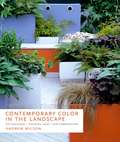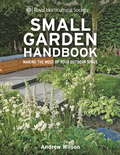- Table View
- List View
Victorian Cottage Residences
by Andrew Jackson DowningThis incredibly rich, firsthand source for the most popular styles of 19th-century Victorian architecture presents 26 cottage designs -- including Gothic, bracketed, Italianate, "rustic," more -- and 155 illustrations (includes floor plans). The small, inexpensive detached house received one of its earliest popularizations here.
The Royal Inca Tunic: A Biography of an Andean Masterpiece
by Andrew James HamiltonThe hidden life of the greatest surviving work of Inca artThe most celebrated Andean artwork in the world is a five-hundred-year-old Inca tunic made famous through theories about the meanings of its intricate designs, including attempts to read them as a long-lost writing system. But very little is really known about it. The Royal Inca Tunic reconstructs the history of this enigmatic object, presenting significant new findings about its manufacture and symbolism in Inca visual culture.Andrew James Hamilton draws on meticulous physical examinations of the garment conducted over a decade, wide-ranging studies of colonial Peruvian manuscripts, and groundbreaking research into the tunic&’s provenance. He methodically builds a case for the textile having been woven by two women who belonged to the very highest echelon of Inca artists for the last emperor of the Inca Empire on the eve of the Spanish invasion in 1532. Hamilton reveals for the first time that this imperial vestment remains unfinished and has suffered massive dye fading that transforms its appearance today, and he proposes a bold new conception of what this radiant masterpiece originally looked like.Featuring stunning photography of the tunic and Hamilton&’s own beautiful illustrations, The Royal Inca Tunic demonstrates why this object holds an important place in the canon of art history as a deft creation by Indigenous women artists, a reminder of the horrors of colonialism, and an emblem of contemporary Andean identity.
Wabi Sabi
by Andrew JuniperWabi sabi, the quintessential Japanese design aesthetic, is quickly gaining popularity around the world, as evidenced by recent articles in Time, The Chicago Tribune and Kyoto Journal. Taken from the Japanese words wabi, which translates to less is more, and sabi, which means attentive melancholy, wabi sabi refers to an awareness of the transient nature of earthly things and a corresponding pleasure in the things that bear the mark of this impermanence. As a design style, wabi sabi helps us to appreciate the simple beauty in imperfection--of a chipped vase or a rainy day, for example.
Wabi Sabi
by Andrew JuniperWabi sabi, the quintessential Japanese design aesthetic, is quickly gaining popularity around the world, as evidenced by recent articles in Time, The Chicago Tribune and Kyoto Journal. Taken from the Japanese words wabi, which translates to less is more, and sabi, which means attentive melancholy, wabi sabi refers to an awareness of the transient nature of earthly things and a corresponding pleasure in the things that bear the mark of this impermanence. As a design style, wabi sabi helps us to appreciate the simple beauty in imperfection--of a chipped vase or a rainy day, for example.
Wabi Sabi
by Andrew JuniperDeveloped out of the aesthetic philosophy of cha-no-yu (the tea ceremony) in fifteenth-century Japan, wabi sabi is an aesthetic that finds beauty in things imperfect, impermanent, and incomplete. Taken from the Japanese words wabi, which translates to less is more, and sabi, which means attentive melancholy, wabi sabi refers to an awareness of the transient nature of earthly things and a corresponding pleasure in the things that bear the mark of this impermanence. As much a state of mind--an awareness of the things around us and an acceptance of our surroundings--as it is a design style, wabi sabi begs us to appreciate the simple beauty in life--a chipped vase, a quiet rainy day, the impermanence of all things. Presenting itself as an alternative to today's fast-paced, mass-produced, neon-lighted world, wabi sabi reminds us to slow down and take comfort in the simple, natural beauty around us.In addition to presenting the philosophy of wabi-sabi, this book includes how-to design advice--so that a transformation of body, mind, and home can emerge.Chapters include:History: The Development of Wabi SabiCulture: Wabi Sabi and the Japanese CharacterArt: Defining AestheticsDesign: Creating Expressions with Wabi Sabi MaterialsSpirit: The Universal Spirit of Wabi Sabi
Growing the Northeast Garden: Regional Ornamental Gardening (Regional Ornamental Gardening Series)
by Andrew Keys Kerry MichaelsPlant selection and garden style are deeply influenced by where we are gardening. To successfully grow a range of beautiful ornamental plants, every gardener has to know the specifics of the region’s climate, soil, and geography. Gardeners in the northeast are lucky—the regular summer rain, gorgeous summer blooms, and stunning fall color make it an ideal place to garden. But there are drawbacks, like hot and humid summers, bitterly cold winters, and mosquitos. TThe practical and beautiful Growing the Northeast Garden starts with a comprehensive overview of the weather and geography of the area, along with regionally specific advice on zones, microclimates, soil, pests, and maintenance. Profiles of the best trees, shrubs, perennials, annuals, and bulbs offer hundreds of plant suggestions, along with complete information on growth and care.
Annuals
by Ted Martson Andrew LawsonArranged like an encylopedia, Annuals discusses the variety, proper care and importance of growing annual plants.
Learning from Bryant Park: Revitalizing Cities, Towns, and Public Spaces
by Andrew M. ManshelBy the 1970s, 42nd Street in New York was widely perceived to be unsafe, a neighborhood thought to be populated largely by drug dealers, porn shops, and muggers. But in 1979, civic leaders developed a long-term vision for revitalizing one especially blighted block, Bryant Park. The reopening of the park in the 1990s helped inject new vitality into midtown Manhattan and served as a model for many other downtown revitalization projects. So what about urban policy can we learn from Bryant Park? In this new book, Andrew M. Manshel draws from both urbanist theory and his first-hand experiences as a urban public space developer and manager who worked on Bryant Park and later applied its strategies to an equally successful redevelopment project in a very different New York neighborhood: Jamaica, Queens. He candidly describes what does (and doesn’t) work when coordinating urban redevelopment projects, giving special attention to each of the many details that must be carefully observed and balanced, from encouraging economic development to fostering creative communities to delivering appropriate services to the homeless. Learning from Bryant Park is thus essential reading for anyone who cares about giving new energy to downtowns and public spaces.
Understanding Metropolitan Landscapes
by Andrew MacKenzieUnderstanding Metropolitan Landscapes considers and reflects on the fundamental relationships between metropolitan regions and their landscapes. It investigates how planning and policy help to protect, manage and enhance the landscapes that sustain our urban settlements. As global populations become more metropolitan, landscapes evolve to become increasingly dynamic and entropic; and the distinction between urban and non-urban is further fragmented and yet these spaces play an increasingly important role in sustainable development. This book opens a key critical discussion into the relational aspects of city and landscape and how each element shapes the boundaries of the other, covering topics such as material natures, governance systems, processes and policy. It presents a compendium of concepts and ideas that have emerged from landscape architecture, planning, and environmental policy and landscape management. Using a range of illustrated case studies, it provokes discussions on the major themes driving the growth of cities by exploring the underlying tensions around notions of sustainable settlement, climate change adaption, urban migration, new modes of governance and the role of landscape in policy and decision making at national, provincial and municipal levels.
Parametric Design for Landscape Architects: Computational Techniques and Workflows
by Andrew MadlParametric Design for Landscape Architects provides a sequence of tutorial-based workflows for the creation and utilization of algorithmic tools calibrated toward the field of landscape architecture. Contemporary practice and projective theory in landscape architecture require the processing and design of data associated with complex systems to adequately represent composite, emergent scenarios. Aligning to both traditional and nascent processes of analysis and digital modeling, this book unpacks and decodes the characterization of algorithmic-based automation, leveraging software that is widely accessible in both academia and professional practice. Curated throughout are workflows that apply to a multiplex of computation programs that widely support the design, analysis, and production of landscapes, primarily concentrated on digital modeling tools Grasshopper and Rhinoceros. It is a much-needed, visually accessible resource to aid in more efficient understanding and creation of tools that automate and re-examine traditional calculations, analyses, drawing standards, form-finding strategies, fabrication preparations, and speculative assessments/simulation. This primer provides professionals and students with multifaceted skill-sets that, when applied in practice, expand and expedite conventional and speculative design workflows applicable to spatial design, and more specifically landscape architecture. The book includes over 200 full-colour drawings, images, and tables to illustrate and support examples throughout.
How to Get Things Really Flat: Enlightenment for Every Man on Ironing, Vacuuming and Other Household Arts
by Andrew MartinIncludes actual instructions! “You might not think that a book about cleaning could be funny but this made me laugh out loud” (The Financial Times). For many reasons, men often neglect housekeeping chores—even when they share the house with other humans who wish they could get some help in that department. How to Get Things Really Flat combines witty observations, true tales of family life, useful information that takes the mystery out of such phenomena as dishwashers and vacuums, and answers to timeless questions including: During dusting, where does the dust go?What is the worst thing that can happen while ironing?Is housework therapeutic?How can I impress people with bicarbonate of soda?Aren’t men supposed to be dirty?And more! “A delightfully amusing tale about the joys and tribulations of doing housework that also serves as a very good primer on how to actually do housework . . . His main target audience is men. But women, I think, will also find Martin’s observations funny and many of his tips helpful . . . And if, after laughing your way through Martin’s text, you’re still not into doing housework, he has a tip for that, too: Hire a cleaner.” —Minneapolis Star-Tribune “Martin’s lighthearted but quite handy guide looks at the reasons why men don’t help out around the house as much as they ought to and proposes what can be done about that . . . After reading this offbeat and thoroughly delightful guide to housework, it’s hard to imagine anyone not wanting to give this stuff a try. Martin does what your mother never could: he makes doing chores seem fun, exciting, and rewarding.” —Booklist
Undesign: Critical Practices at the Intersection of Art and Design
by Andrew McNamara Gretchen Coombs Gavin SadeUndesign brings together leading artists, designers and theorists working at the intersection of art and design. The text focuses on design practices, and conceptual approaches, which challenge the traditional notion that design should emphasise its utility over aesthetic or other non-functional considerations. This publication brings to light emerging practices that consider the social, political and aesthetic potential of "undesigning" our complex designed world. In documenting these new developments, the book highlights the overlaps with science, engineering, biotechnology and hacktivism, which operate at the intersection of art and design.
The Pacific Northwest Native Plant Primer: 225 Plants for an Earth-Friendly Garden
by Kristin Currin Andrew MerrittNative plants bring your garden to life—and life to your garden! Here are the best choices for Oregon and Washington. The benefits of native plants are enormous—they reduce maintenance, require less water, and attract vital, earth-friendly pollinators like birds, butterflies, and bees. Gardeners seeking to add them to their landscape will find no better guide than The Pacific Northwest Native Plant Primer. Packed with proven advice that everyhome gardener can follow, this incomparable sourcebook profiles 225 recommended native wildflowers, grasses and grasslike plants, ferns, shrubs, and trees. With additional introductory information on preparation, planting, maintenance, and climate considerations, it&’s everything you need to know to create a beautiful and beneficial garden. This must-have handbook is for gardeners in Oregon, Washington, and southern British Columbia.
Grow Orchids: Essential Know-how and Expert Advice for Gardening Success (DK Grow)
by Andrew MikolajskiDK brings you a horticultural handbook to fulfill your every need and seed! Get your gardening gloves on and join the green-fingered journey to growing orchids successfully at home. Ideal for first-time gardeners, Grow Orchids contains everything you need to raise stunning, long-lasting blooms for your indoor space.Learn how to grow and care for various orchids with tips on positioning, feeding, watering, and propagation. A handy troubleshooting guide shows you how to recognize ailing plants, revive neglected orchids, and spot common diseases. From hanging baskets and bark rafts to corsages and bridal bouquets, get inspired and create thriving collections of orchids for your home.With passion on every page, you can enjoy the following: -A practical guide to harvesting home-grown orchids. -Easy to follow step-by-step instructions of fundamental gardening techniques.-Exploration of popular flowers as well as lesser-known options.Let It Grow! Whilst many people use their gardens to grow fruits, flowers, herbs, and more, the ever-growing pressure of balancing family life with a career suggests a lot of today’s green-fingered gardeners simply lack time for gardening. We believe it’s time to change that!Whatever your horticultural hopes may be, author Insert Name Here brings you a growers guide that will shape your gardening journey like never before, full of top tips to help your garden thrive! An ideal gift for first-time gardeners, budding botanists, or the green-fingered lover in your life, make sure to get those gardening gloves on and join the journey today!At DK, we believe in the power of discovery. If you like Grow Orchids, why not try the other titles in our Grow series? Learn how to brighten your garden all year round with Grow Bulbs, enjoy a no-fuss guide to container gardening with Grow Containers or minimize garden waste with Grow Eco-Gardening. Ready, set, let’s grow!
Tiny House Designing, Building & Living
by Andrew Morrison Gabriella MorrisonDo you have what it takes to live tiny?Do you dream of simplifying your life, freeing up your financial resources and ditching all of the clutter in your life? Learn the ins and outs of what it really takes to achieve the dream of designing, building and living in a tiny house of 400 square feet or less!Tiny house professionals, Gabriella and Andrew Morrison, have been involved in the trade for over 20 years, helping others to construct their own tiny homes. They have instilled all of their expertise and firsthand experience into this newly updated guide.Tiny House Designing, Building & Living is the one-stop manual into the innovative concept of minimalist living. There are dozens of helpful images and a full-color insert displaying different varieties of tiny houses to help you conceptualize your dream.In this newly updated guide you'll discover: • Advice on how to embrace the tiny house lifestyle!• How to design and build a house that's an ideal fit for your needs.• The variations of foundation types, financing, insurance and legal standards.• Building techniques, must-have utilities, off-the-grid living and home placement.• Inspiration for functional décor and storage.• Three tiny house floor plans with detailed illustrations!
Tiny House Designing, Building, & Living (Idiot's Guides)
by Andrew Morrison Gabriella MorrisonDo you have what it takes to live tiny?Do you dream of simplifying your life, freeing up your financial resources, and ditching all of the clutter that's weighing you down? Learn the nuts and bolts of what it really takes to achieve this dream of designing, building, and living in a tiny house of 400 square feet or less!Tiny house professionals Gabriella and Andrew Morrison have been involved in the trade for over 20 years, helping others to construct their own tiny homes, and they have poured all of their expertise and firsthand experience into this guide.Tiny House Designing, Building, and Living is the one-stop manual into this innovative concept of minimalist living. Dozens of helpful images and a full-color insert displaying different types of tiny houses help you visualize your dream. • Advice on how to embrace the tiny house lifestyle! • How to design and build a house that's an ideal fit for your needs. • The nuances of foundation types, financing and insurance, and legal standards • Building techniques, must-have utilities, off-the-grid living, and home placement. • Inspiration for functional décor and storage. • Three tiny house floor plans, with detailed illustrations!
Cities for the New Millennium
by Andrew Saint Marcial EcheniqueCities for the New Millennium is the outcome of a joint conference held in Salford in July 2000 by the Royal Institute of British Architects and the University of Cambridge's Department of Architecture. It tackles these questions in the light of the Urban Task Force's report about the future of Britain's cities and communities, but sets them in an international and historical context. Professionals - architects, engineers and developers as well as academics from different countries and disciplines here lavish their expertise on issues of transportation, density, land use, risk and energy saving; others present urban-scale buildings or landscapes that have been judged inspirational or inventive. This book, therefore, is not just about theories of urbanism. It reveals how co-operation and debate between different parties and professions can illuminate the creative kind of urban development we should be aiming for.
ReNew Town: Adaptive Urbanism and the Low Carbon Community (Routledge Contemporary Asia Ser.)
by Eran Ben-Joseph Andrew ScottReNew Town puts forth an innovative vision of performative design and planning for low-carbon sustainable development, and illustrates practicable strategies for balancing environmental systems with urban infrastructure and new housing prototypes. To date, much of the discourse on the design of sustainable communities and ‘eco-cities’ has been premised on using previously undeveloped land. In contrast, this book and the project it showcases focus on the retrofitting and adaptation of an existing environment – a more common problem, given the extent of the world’s already-built infrastructure. Employing a ‘research through design’ model of inquiry, the book focuses on large-scale housing developments – especially those built around the world between the 1960s and the early 1980s – with the aim of understanding how best to reinvent them. At the center of the book is Tama New Town, a planned community outside Tokyo that faces a range of challenges, such as an aging population, the deterioration of homes and buildings, and economic stagnation. The book begins by outlining a series of principles that structure the ecological and energy goals for the community. It then develops prototypical solutions for designing, building and retrofitting neighborhoods. The intent is that these prototypes could be applied to similar urban conditions around the world. ReNew Town is the product of a collaborative design research project at the Massachusetts Institute of Technology (MIT) School of Architecture and Planning, and Japan’s Sekisui House LTD.
Nature of the City: Green Infrastructure from the Ground Up
by Tom Armour Andrew TempanyThis is a practical guide to delivering green infrastructure from the ground up and bringing nature in to the built environment. Exploring the process of delivery through an array of design approaches and case studies, it demystifies the concept and provides the tools for practical implementation - highlighting the challenges and opportunities on both small and large projects.
To Stand and Stare
by Andrew Timothy O'BrienReconnect with nature from the ground up and nurture not only your garden but your body, mind, and soul.There&’s a lot of advice out there that would tell you how to do numerous things in your garden. But not so much that invites you to think about how to be while you&’re out there. With increasingly busy lives, yet another list of chores seems like the very last thing any of us needs when it comes to our own practice of self-care, relaxation and renewal. After all, aren&’t these the things we wanted to escape to the garden for in the first place? Put aside the &‘Jobs to do this week&’ section in the Sunday papers. What if there was a more low-intervention way to garden, some reciprocal arrangement through which both you and your soil get fed, with the minimum degree of fuss, effort and guilt on your part, and the maximum measure of healthy, organic growth on that of your garden? A gardening book unlike anything you've read before:- A celebration of the quiet joy of gardening, and the importance of delighting in nature's wonders.- A season-by-season reflection of the garden's rhythms and our place within them.-An exploration of the natural processes at work in the garden and how tapping into them can transform both your gardening experience and your life.In To Stand and Stare, Andrew Timothy O&’Brien weaves together strands of botany, philosophy and mindfulness to form an ecological narrative suffused with practical gardening know-how. Informed by a deep understanding and appreciation of natural processes, O&’Brien encourages the reader to think from the ground up, as we follow the pattern of a plant&’s growth through the season – roots, shoots, flowers, and fruits – while advocating an increased awareness of our surroundings.
Routledge Revivals: The Politics of Urban Change (1979)
by David H. McKay Andrew W. CoxFirst published in 1979, this book examines key planning policy areas such as land use planning, land values, housing and slum clearance, urban transport, industrial and regional economic location policies, and policies inner city policies to explain why particular policies have been adopted at particular times — assessing the role of political parties, bureaucrats and interests in setting the national policy agenda. Policy is also placed in the broader economic and social context and the question of whether, given contemporaneous constraints, a coherent national urban policy is possible is examined. Its focus on political parties’ role in urban change at the start of Thatcher-era upheavals makes this book especially valuable to students of urban sociology and the history of planning.
Cannabis Jobs: How to Make a Living and Have a Career in the World of Legalized Marijuana
by Andrew Ward&“Andrew Ward spills the beans on how to obtain a job or full-blown career in the cannabis industry. Brooklyn-based freelance cannabis writer Ward should know, as he has covered the industry for over a decade for Benzinga and Merry Jane, among other media outlets.&” —Forbes As of 2019, eleven states (and Washington, DC) have legalized recreational marijuana use with another twenty-two having legalized medical marijuana, and those numbers will only continue to rise. Cannabis career opportunities are beginning to take off across the country and beyond. In fact, Forbes noted the industry is projected to create more jobs than manufacturing by 2020.With the rise in legalization, virtually any job in the American market can be replicated in the cannabis industry. From working in a dispensary to social media, IT to HR, marketing to quality assurance, millions of future professionals are looking at cannabis as a future career path. Andrew Ward, who has been covering the growing cannabis industry for over a decade, shares the vast stretch of potential careers. In addition to job opportunities, Ward supplies career growth, salaries, and first-hand knowledge from professionals who have made a career in the field. But as with any industry, there are pros and cons. While the market is expanding, every profession has growing pains, and Ward explains them in detail. In addition to potential jobs, Ward explores other options, such as freelancing and starting your own business. For those either looking to find a new career or preparing to join the workforce, Cannabis Jobs offers the most in-depth information available.
Hollyhock: Garden to Table
by Andrew Weil Moreka Jolar Heidi ScheifleyHollyhock-renowned the world over as an unparalleled center of learning and connection-exists to inspire, nourish, and support people who are making the world better. At the heart of this unique institution, located on beautiful Cortes Island, is Hollyhock's spectacular organic garden, just steps from the ocean view kitchen. Serving up exquisite meals for thirty years, the Hollyhock cooks are back with a new collection, boasting over two hundred new garden-inspired recipes.Hollyhock: Garden to Table invites you to join in a celebration of the beauty of fresh, local food-filled with imaginative ideas and seasoned with global inspiration. The versatility of whole grains, healthy oils, and natural sweeteners is showcased in mouthwatering creations such as:Thin-Crust Pizza with Nettle Pesto and Roasted Sweet Potatoes, Asparagus, and ChevreBlack Sesame Crusted Albacore Tuna with Ponzu SauceSoft Polenta with Roasted Butternut Squash, Caramelized Onions, Peas, and Smoked CheddarHoney Roasted Pears with Balsamic and MascarponeFocusing on sustainable seafood and garden-fresh foods from wherever you are, Hollyhock: Garden to Table will have you leafing through its pages for your next great meal again and again. Welcome to the Hollyhock kitchen!Moreka Jolar has been a chef at Hollyhock for fifteen years. She is co-author of the best-selling cookbook Hollyhock Cooks.Heidi Scheifley is a certified gourmet natural foods chef who has cooked in kitchens from Hollyhock on Cortes Island, Canada to Greece to Southeast Asia, Egypt, Israel, Nepal, India, and Hawaii.
Contemporary Color in the Landscape: Top Designers, Inspiring Ideas, New Combinations
by Andrew WilsonColor is the first and most important design choice a garden designer makes. Over the past decade, landscape architects and garden designers have moved away from the more sedate shades commonly found in traditional gardens and have used plants and hardscape to experiment with explosions of color. From the layered and textural colors of Piet Oudolf to the high contrast colors of Tom Stuart Smith, this increased focus on color is a trademark of today’s leading designers. Contemporary Color in the Landscape explores the whole spectrum of color: how we perceive and respond to color, how to design with color, how to manipulate contrast and create intensity with saturation, how to maximize impact by minimizing color, how to find your own personal color combinations, and how color is viewed in nature. In gorgeous, color-drenched photos Andrew Wilson showcases the work of leading garden designers as inspiring examples of the way color is used. Innovative gardens from all over the world help the reader visualize the core color lessons throughout the book. Supported by more than 300 stunning photographs, Contemporary Color in the Landscape integrates cutting-edge designers, their landscapes, color theory, new design ideas, and gorgeous photography into one inspirational, instructional, and must-have guide for design professionals.
RHS Small Garden Handbook: Making the most of your outdoor space (Royal Horticultural Society Handbooks Ser.)
by Andrew Wilson'RHS Small Garden Handbook...show[s] the process of planning, planting and maintaining an outdoor space that will lift your heart every time you step outside.' - The Independent 'Clear and practical principles of design' - BBC Gardens IllustratedA garden offers invaluable space for relaxing entertaining, and, above all, enjoying the huge pleasure of growing your own flowers, shrubs, trees, and crops. However, a small garden can present challenges to even the most experience gardener: it may be overlooked, which can impact upon your privacy; there may be more shade than you would like; and it may not be immediately obvious how to create a space that is both multifunctional and beautiful. RHS Small Garden Handbook provides an all-in-one guide for small space gardeners and draws on the experience in growing, planting, landscaping and design for which the RHS is world famous. It begins by explaining how to assess your plot so that you are aware of the soil, orientation, microclimate, existing materials and proportions that you have to work with, before revealing the principles of good design. Showing how your decisions on layout, colour and texture will affect the finished design and what tricks can be played to create a greater sense of space - with everything from expert design advice on boundaries, hedges and fences to clever ideas for containers and storage - every gardener will gain confidence in creating a garden to enjoy no matter how big the plot. Each of the nine chapters includes 15 ways to make instant improvements and a real-life case study to inspire change. All the gardens featured in the book's 300 photographs are accessible, achievable and truly inspirational.Contents Includes...BasicsDesign StylesMaterialsBoundariesStructuresWater PlantingUpkeep... and much much more!
